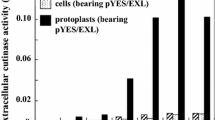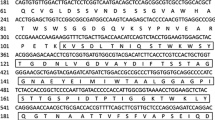Summary
Efficient production of α-mating factor with immobilized growing Saccharomyces cerevisiae cells was examined in order to establish a secretion system for useful peptides using the α-mating factor secretion system. The free yeast cells produced α-mating factor into the cultured medium, but α-mating factor was gradually degraded in situ. Based on the criteria of α-mating factor productivity, cell growth in gels, cell leakage from gels, and mechanical strength of gels, a mixture of a hydrophilic neutral photo-crosslinkable resin prepolymer (ENT-2000) and an anionic prepolymer (ENTA-2) (8:2 by weight) was employed as gel material, among various kinds of natural and synthetic supports, to entrap the yeast cells. Anionic photo-crosslinkable resins selectively entrapped α-mating factor-degrading enzymes which were produced by the cells and degraded α-mating factor formed. The immobilized growing yeast cells could be used successfully for continuous production of α-mating factor in a packed column reactor for at least 30 days.
Similar content being viewed by others
References
Brown SW, Meyer H-P, Fiechter A (1985) Continuous production of human leukocyte interferon with Escherichia coli and continuous cell lysis in a two stage chemostat. Appl. Microbiol Biotechnol 23:5–9
Burkholder AC, Hartwell LH (1985) The yeast α-factor receptor: structural properties deduced from the sequence of the STE2 gene. Nucl Acids Res 13:8463–8475
Fukui S, Tanaka A (1984) Application of biocatalysts immobilized by prepolymer methods. Adv Biochem Eng Biotechnol 29:1–33
Fukui S, Sonomoto K, Itoh N, Tanaka A (1980) Several novel methods for immobilization of enzymes, microbial cells and organelles. Biochimie 62:381–386
Georgiou G, Chalmers JJ, Schuler ML, Wilson DB (1985) Continuous immobilized recombinant protein production from E. coli capable of selective protein excretion: a feasibility study. Biotechnol Progress 1:75–79
Julius D, Blair L, Brake A, Sprague G, Thorner J (1983) Yeast α-factor is processed from a larger precursor polypeptide: the essential role of a membrane-bound dipeptidyl aminopeptidase. Cell 32:839–852
Julius D, Brake A, Blair L, Sprague G, Thorner J (1984) Isolation of the putative structural gene for the lysine-arginine-cleaving endopeptidase required for processing of yeast prepro-α-factor. Cell 37:1075–1089
Kurjan J, Herskowitz I (1982) Structure of a yeast pheromone gene (MFα): a putative α-factor precursor contains four tandem copies of mature α-factor. Cell 30:933–943
Levi JD (1956) Mating reaction in yeast. Nature 177:753–754
Mosbach K, Birnbaum S, Hardy K, Davies J, Bülow L (1983) Formation of proinsulin by immobilized Bacillus subtilis. Nature 302:543–545
Ogaki M, Sonomoto K, Nakajima H, Tanaka A (1986) Continuous production of oxytetracycline by immobilized growing Streptomyces rimosus cells. Appl Microbiol Biotechnol 24:6–11
Sonomoto K, Hoq MM, Tanaka A, Fukui S (1981) Growth of Curvularia lunata spores into mycelial form within various gels, and steroid 11β-hydroxylation by the entrapped mycelia. J Ferment Technol 59:465–469
Tanaka T, Kita H (1977) Degradation of mating factor by α-mating type cells of Saccharomyces cerevisiae. J Biochem 82:1689–1693
Tanaka T, Kita H, Murakami T, Narita K (1977) Purification and amino acid sequence of mating factor from Saccharomyces cerevisiae. J Biochem 82:1681–1687
Author information
Authors and Affiliations
Rights and permissions
About this article
Cite this article
Okada, T., Sonomoto, K. & Tanaka, A. Application of entrapped growing yeast cells to peptide secretion system. Appl Microbiol Biotechnol 26, 112–116 (1987). https://doi.org/10.1007/BF00253892
Received:
Revised:
Issue Date:
DOI: https://doi.org/10.1007/BF00253892




